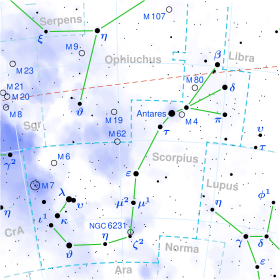Shaula
| Observation data Epoch J2000 Equinox J2000 |
|
|---|---|
| Constellation | Scorpius |
| Right ascension | 17h 33m 36.520s |
| Declination | −37° 06′ 13.76″ |
| Apparent magnitude (V) | 1.62 / 14.9 / 12.0 |
| Characteristics | |
| Spectral type | B2IV+DA7.9 |
| U−B color index | −0.880 |
| B−V color index | −0.240 |
| Variable type | Beta Cephei (A) |
| Astrometry | |
| Radial velocity (Rv) | −3.00 km/s |
| Proper motion (μ) |
RA: −8.90 mas/yr Dec.: −29.95 mas/yr |
| Parallax (π) | 5.71 ± 0.90mas |
| Distance | approx. 570 ly (approx. 180 pc) |
| Absolute magnitude (MV) | −3.70 |
| Details | |
| λ Sco A | |
| Mass | 14.5±1.1 M☉ |
| Radius | 8.8±1.2 R☉ |
| Luminosity | 36,300 L☉ |
| Surface gravity (log g) | 3.8 cgs |
| Temperature | 25,000±1,000 K |
| Rotational velocity (v sin i) | 150 km/s |
| λ Sco B | |
| Mass | 9.6-11.6 M☉ |
| Radius | 4.7±1.0 R☉ |
| Surface gravity (log g) | 4.0 cgs |
| Temperature | 25,000±1,000 K |
| Other designations | |
| Database references | |
| SIMBAD | data |
| Data sources: | |
|
CCDM (2002), Simbad |
|
Lambda Scorpii (λ Scorpii, abbreviated Lambda Sco, λ Sco), also named Shaula, is (despite being designated 'Lambda') the second brightest star system in the constellation of Scorpius, and one of the brightest stars in the nighttime sky.
λ Scorpii (Latinised to Lambda Scorpii) is the star's Bayer designation.
It bore the traditional name Shaula, which comes from the Arabic الشولاء al-šawlā´ meaning 'the raised [tail]', as it is found in the tail of the scorpion (Scorpius). In 2016, the International Astronomical Union organized a Working Group on Star Names (WGSN) to catalog and standardize proper names for stars. The WGSN's first bulletin of July 2016 included a table of the first two batches of names approved by the WGSN; which included Shaula for this star.
It is known as Wei Xiu Ba 尾宿八 (the Eighth Star of the Tail) in Chinese.
Together with Upsilon Scorpii (Lesath), Shaula is listed in the Babylonian compendium MUL.APIN as dSharur4 u dShargaz, meaning "Sharur and Shargaz".
In Coptic, they were called Minamref.
The indigenous Boorong people of northwestern Victoria named it (together with Upsilon Scorpii) as Karik Karik, "the Falcons".
Lambda Scorpii is located some 570 light years away from the Sun.
Spectroscopic and interferometric observations have shown that it is actually a triple system consisting of two B-type stars and a pre–main sequence star. The primary star is a beta Cephei variable star with rapid brightness changes of about a hundredth of a magnitude. The pre–main sequence star has an orbital period of 6 days and the B companion has a period of 1053 days. The three stars lie in the same orbital plane, strongly suggesting that they were formed at the same time. The masses of the primary, pre–main sequence star and the B companion are 14.5, 2.0 and 10.6 solar masses, respectively. The age of the system is estimated to be in the range 10–13 million years.
...
Wikipedia

